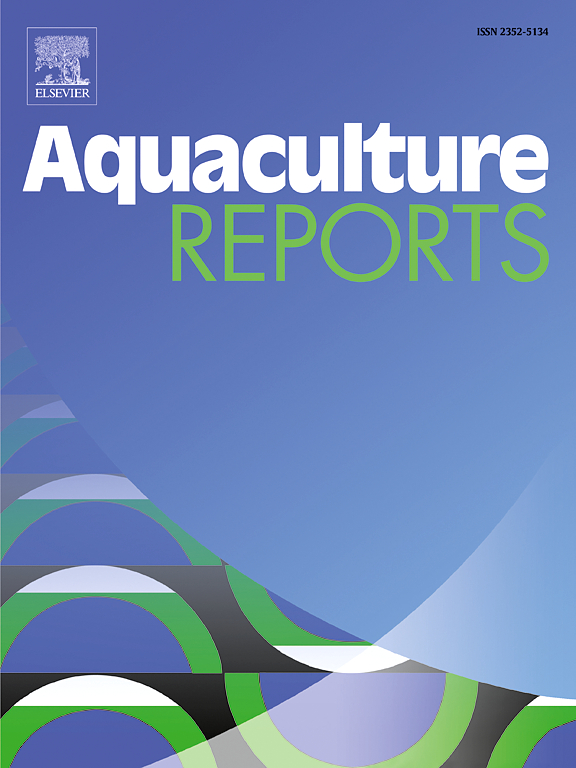Evaluating the response of Schizothorax prenanti to ammonia nitrogen stress using computer vision and transcriptomics
IF 3.2
2区 农林科学
Q1 FISHERIES
引用次数: 0
Abstract
The tolerance and response to ammonia nitrogen have not been studied in Schizothorax prenanti (S. prenanti), an important economic fish in southwest China. This study, for the first time, combines behavioral, histological, biochemical, and transcriptomic analyses to explore its response to ammonia nitrogen stress. Acute toxicity tests showed that the 96 h LC50 TAN (total ammonia nitrogen) in S. prenanti was approximately 16 mg/L (temperature = 21°C, pH = 7.5). Behavioral quantification using YOLO v8 (You Only Look Once version 8) indicated no significant impact under low-concentration stress (L, 30 % LC50); medium-concentration stress (M, 45 % LC50) significantly enhanced the swimming speed, exercise volumes, and localized activity, and high-concentration stress (H, 60 % LC50) caused abnormal behavior and restricted activity. Gill histology and TUNEL assay revealed epithelial swelling and curling of secondary filaments under low-concentration stress. Medium-concentration stress caused localized structural damage and cell apoptosis and high-concentration stress induced severe necrosis and apoptosis in the secondary filaments. Biochemical tests showed significant increases in plasma cortisol, glucose, plasma ammonia, and tumor necrosis factor-α under high-concentration stress. Gill superoxide dismutase, catalase, and total antioxidant capacity activities were significantly decreased and malondialdehyde levels were increased. Transcriptomic analysis indicated that most differentially expressed genes (DEGs) in the M and H groups were enriched in pathways related to immune response, antioxidation, carbohydrate metabolism, and amino acid metabolism. Notably, DEGs related to the TCA cycle and oxidative phosphorylation were enriched in the M group, likely to provide energy for immune response and ammonia detoxification. Suppression of antigen processing and presentation may explain why S. prenanti struggles to cope under high ammonia nitrogen stress. S. prenanti shows a certain tolerance to ammonia nitrogen, however, concentrations exceeding 9.6 mg/L result in behavioral abnormalities, gill tissue damage, oxidative stress, apoptosis, and immune suppression. The findings provide a theoretical foundation for research on the tolerance and response of S. prenanti to ammonia nitrogen and offer a new perspective for monitoring and managing ammonia nitrogen stress in intensive aquaculture systems.
利用计算机视觉和转录组学评价南裂胸对氨氮胁迫的响应
华南裂腹鱼(Schizothorax prenanti, S. prenanti)是中国西南地区重要的经济鱼类,目前尚未对其对氨氮的耐受性和响应进行研究。本研究首次将行为学、组织学、生物化学和转录组学分析相结合,探讨其对氨氮胁迫的反应。急性毒性试验表明,在温度= 21℃,pH = 7.5条件下,S. prenanti体内96 h LC50 TAN(总氨氮)约为16 mg/L。使用YOLO v8 (You Only Look Once version 8)的行为量化表明,在低浓度压力下(L, 30 % LC50)没有显著影响;中浓度应激(M, 45 % LC50)显著提高游泳速度、运动量和局部活动,高浓度应激(H, 60 % LC50)导致行为异常和活动受限。鳃组织和TUNEL分析显示,在低浓度胁迫下,上皮组织肿胀,次生细丝卷曲。中等浓度胁迫引起局部结构损伤和细胞凋亡,高浓度胁迫引起次生纤维严重坏死和细胞凋亡。生化试验显示高浓度应激下血浆皮质醇、葡萄糖、血浆氨、肿瘤坏死因子-α显著升高。鳃超氧化物歧化酶、过氧化氢酶和总抗氧化能力活性显著降低,丙二醛水平显著升高。转录组学分析表明,M组和H组中大多数差异表达基因(DEGs)富集于与免疫应答、抗氧化、碳水化合物代谢和氨基酸代谢相关的途径。值得注意的是,与TCA循环和氧化磷酸化相关的DEGs在M组中富集,可能为免疫反应和氨解毒提供能量。抑制抗原加工和呈递可能解释了为什么S. prenanti在高氨氮胁迫下挣扎。S. prenanti对氨氮有一定的耐受性,但浓度超过9.6 mg/L会导致行为异常、鳃组织损伤、氧化应激、细胞凋亡和免疫抑制。该研究结果为研究南水北调对氨氮的耐受性和响应提供了理论基础,并为集约化养殖系统中氨氮胁迫的监测和管理提供了新的视角。
本文章由计算机程序翻译,如有差异,请以英文原文为准。
求助全文
约1分钟内获得全文
求助全文
来源期刊

Aquaculture Reports
Agricultural and Biological Sciences-Animal Science and Zoology
CiteScore
5.90
自引率
8.10%
发文量
469
审稿时长
77 days
期刊介绍:
Aquaculture Reports will publish original research papers and reviews documenting outstanding science with a regional context and focus, answering the need for high quality information on novel species, systems and regions in emerging areas of aquaculture research and development, such as integrated multi-trophic aquaculture, urban aquaculture, ornamental, unfed aquaculture, offshore aquaculture and others. Papers having industry research as priority and encompassing product development research or current industry practice are encouraged.
 求助内容:
求助内容: 应助结果提醒方式:
应助结果提醒方式:


